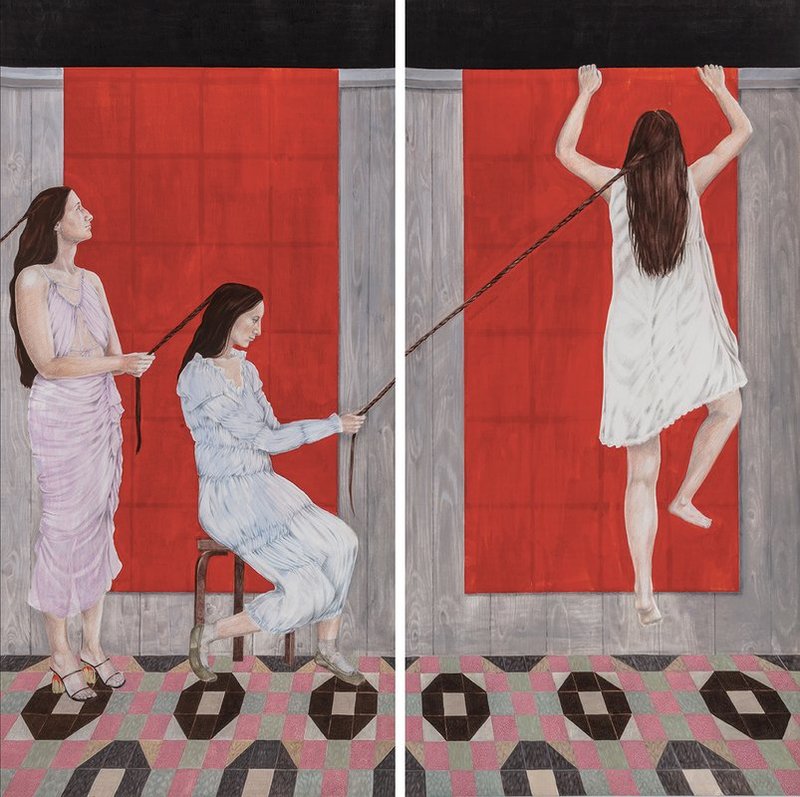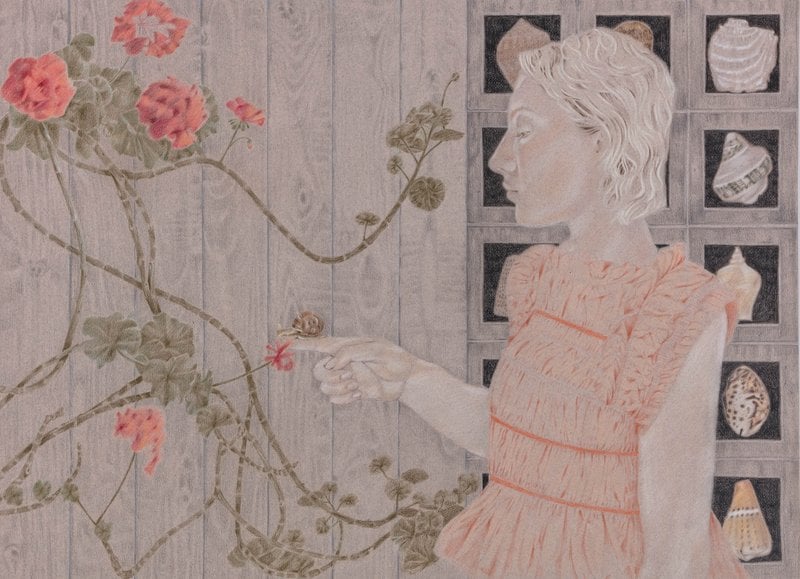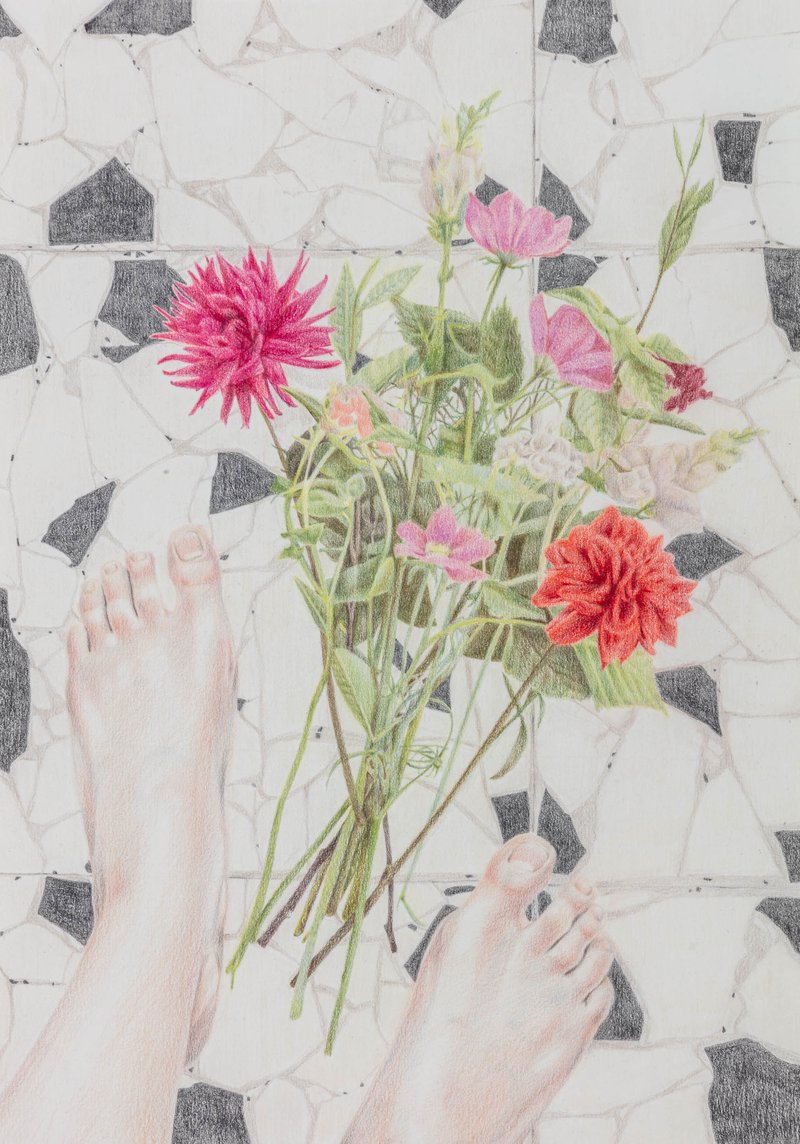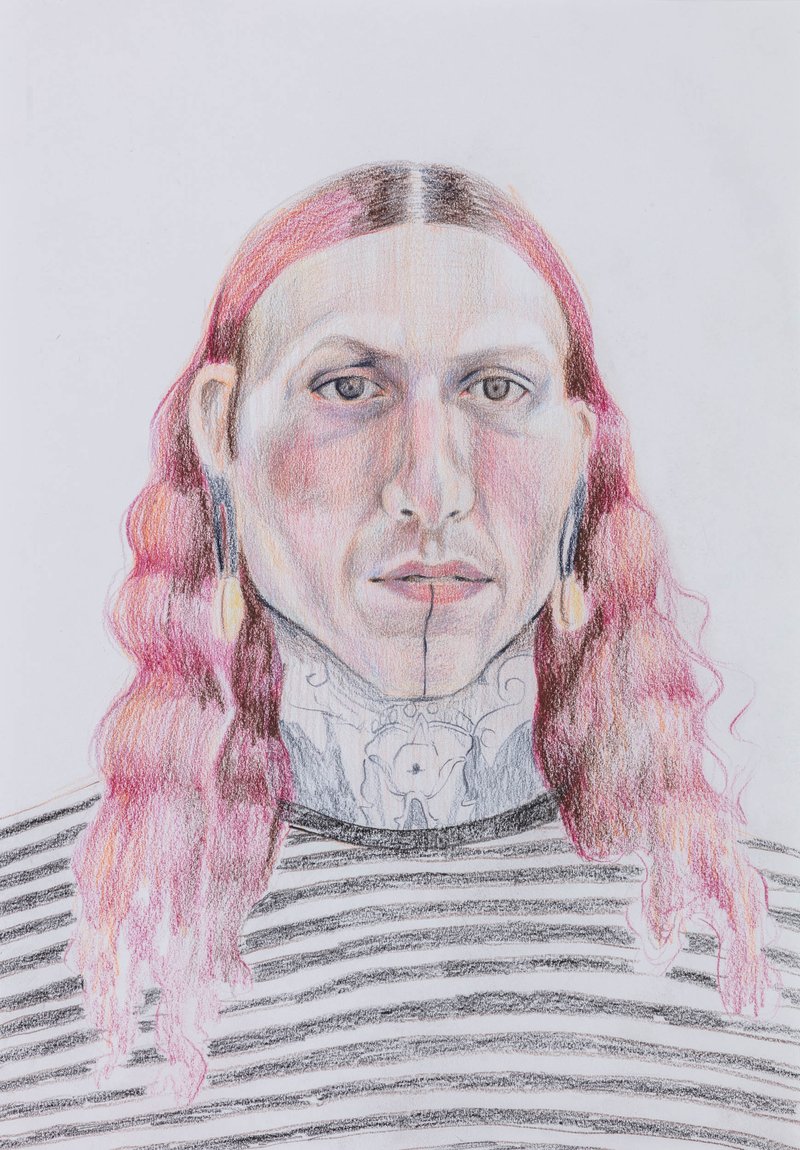

Tell us about your practice and the part that drawing plays...
My work explores personal mythologies, and uses disparate objects, textiles, architectural features, and contrasting textures in dialogue with the human figure. I’m often trying to make sense of my internal world, and multicultural background, by bringing together objects that don’t normally sit next to each other. As such, drawing is always the first step in starting a conversation between objects or textures that speak different visual and cultural languages. It’s a form of mediation, a way of finding points of harmony or conflict. There’s also an important reflexive aspect to it – my initial impetus is almost always a feeling, but as I start sketching out an idea, the act of drawing will reflect back a new dimension to the feeling, so that my internal world is altered by the act of drawing.
What were you doing before The Drawing Year and what drew you to apply?
I’ve drawn and made throughout my life, but I had always felt conflicted about whether or not to focus entirely on my artistic practice or to have a more ‘stable’ career. I briefly studied at Central St Martins for a foundation, but then went on study English Literature at the University of Oxford for my BA, followed by an MA in the History of Design at the Royal College of Art. Before Covid, I was an Assistant Curator in the Furniture, Textiles, and Fashion department at the V&A Museum. However, the project I was working on was cancelled due to Covid and I suddenly found myself going in and out of lockdowns, doing freelance work and with so much time to reconnect with drawing and painting. I started a funded PhD in fashion history, but having reconnected with my practice it felt impossible to carry on with academia. I have a few friends who had done The Drawing Year and I’d seen what it had done for them and their practice. I knew I had to find a way of being able to make art every day and hopefully do it professionally, but having only briefly been to art school for a foundation, I knew I had so much to learn and needed the community and support of tutors and fellow students to help me get there.
Which courses have most impacted your practice?
I think every course I did has impacted my practice in some way, but probably the ones which are the most connected to the work I’m making now are Transforming Observation: Memory and Imagination, Studio Room in Colour, Enduring Images: Stories in Art, and Drawing at the National Gallery. Even though it may not be immediately obvious looking at my work, I also think Ewan Clayton’s classes on the Core days which explore approaches to mark-making, Harry Parker’s class on drawing from childhood memories, and Mark Cazalet’s classes, which emphasise play and pushing you to the edges of your comfort zone, have also had a huge and hopefully long lasting effect on how I approach and understand my practice, particularly the emotional and psychological aspects of it.
Tell us about the sense of community on the course...
The sense of community on the course is amazing and one of the most important aspects of The Drawing Year. One of the reasons the year is so rewarding is that you have to make yourself incredibly vulnerable by constantly trying new things, learning from mistakes and sharing all of that with everyone on a daily basis. This means that you get to know everyone on the year incredibly well and are instantly bonded by sharing such a unique experience. I feel very lucky that there was a real sense of comradery in my year and it never felt competitive. Part of this sense of community comes from doing classes together, but it also comes from sharing a studio space, and going to Tuscany together in the summer. You leave the course with a readymade community that will endure – I’m now sharing a studio with two classmates and go for regular gallery days and openings with others. Something I hadn’t realised before starting The Drawing Year is that most of your classes are with students on the public programme, so not only do you learn so much from them, but I also ended up making friends with a few of them as well, which was an unexpected bonus.
Which tutors have you most enjoyed working with and why?
I found all of the tutors incredibly inspiring and supportive. In particular, I enjoyed working with Ishbel Myerscough, I suppose we share a slightly obsessive love of detail, but I also found her incredibly warm and supportive throughout the year. I had a particularly useful tutorial with her at the end of the second term. Until that point, I had been exploring with different media, trying out different approaches, and drawing in an unnaturally (for me) expressive and loose way, desperately trying to find a new way of working, but she said ‘at some point you have to make peace with the kind of artist you are’, and told me it was time for me to return to myself. It was the perfect timing for that conversation, and I returned to my practice, but with so much more self-knowledge and understanding, and making work which was completely different to when I’d started the course. I also really enjoyed classes with Marcus Cornish, Sarah Pickstone, and Mark Cazalet.
What are the most important things that you've learned during the year?
On the first day of the year, we had a conversation with Catherine Goodman, the Founding Artistic Director of the School. She explained that while The Drawing Year is ostensibly about observational drawing, through observational drawing you learn to observe your internal world better, and that the year is ultimately an internal journey, as well as a practical and technical one. That perfectly describes what I gained from the year – I got to know myself and my creative voice so much better than I ever thought I could. I started the year doing highly detailed, small, monochrome drawings, which weren’t connected to anything that deep, and I’ve left making large-scale colourful images, that narrate internal tensions, and which feel far more like ‘me’ than anything else I was doing before. It sounds like such a cliche, but I do think that although we all changed in many ways, we left the year feeling more ourselves.


What has surprised you about The Drawing Year?
I think how emotionally intense I found it at times, in many ways it felt more like drama school than most art schools. It completely depends on which classes you choose, but many of the classes are about learning to connect with your imagination and emotions, rather than just technical observational drawing. Perhaps that wouldn’t feel so intense for people who had already been to art school, but as someone who had predominantly had an academic background, it felt quite novel to me. But it was exactly what I needed.
How has your approach to drawing changed since the start of the course?
I think when I started the course, I hadn’t really considered all of the various aspects of drawing and its emotional and psychological elements. It’s probably obvious to most people, but I hadn’t thought about how different marks can convey different emotions or moods, how you can think and feel through mark marking – how learning how to incorporate a variety of marks into your practice is like learning to play more notes on a musical instrument. And how learning to see the physical world better teaches you to see other aspects of the world with more clarity. I also think I incorrectly believed that drawing would always sit beneath painting and that the ultimate goal would always be painting, but I ended up making large scale gouache and coloured pencil drawings, which have a variety of textures which I’m not sure I could have achieved with paint.
What opportunities have arisen due to The Drawing Year?
My life has been completely transformed by doing The Drawing Year! I’m currently working toward group shows and a solo show later on this year, which makes me feel like I might actually be able develop my practice professionally.
What does it mean to you that the course has no fees and a free studio space?
I can’t emphasise enough how important it was that the course had no tuition fees and provided a studio space. It would have been impossible for me to attend a fee-paying course; I just could not have afforded it. Without the possibility of a free postgraduate course, I probably wouldn’t have had the guts to risk focusing on my artistic practice and would still be doing a PhD!
What is it like to study and live in London?
I grew up in London and was already living a 20-minute cycle from the School before I started, so I was lucky that the course slotted into my life very easily, but I know for others it was very challenging moving to the city for the first time. Studying in London means that you can get to know all of the collections in the national museums, as well as feel connected to the contemporary art world by going to openings and seeing shows at smaller private galleries. It’s also such a varied city, that I think no matter what kind of artist you are you will always find inspiration in the city.
What advice would you give to someone considering applying for the course?
You absolutely must! You will enhance your practice, learn so much about yourself, and leave with an amazing group of friends. I’d also recommend taking a class before you apply so you know what the energy of the school is like and if you think it will work for you. I’d also encourage people to be themselves in the application – they’re looking for a diversity of approaches and experience.
Sign up for updates
Be the first to hear about The Drawing Year open days, application support and deadlines
.jpg)